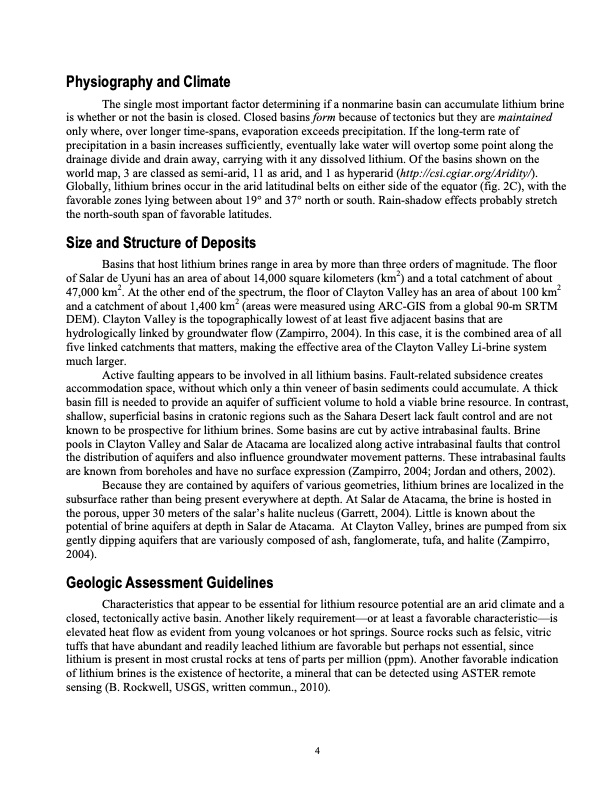
PDF Publication Title:
Text from PDF Page: 007
Physiography and Climate The single most important factor determining if a nonmarine basin can accumulate lithium brine is whether or not the basin is closed. Closed basins form because of tectonics but they are maintained only where, over longer time-spans, evaporation exceeds precipitation. If the long-term rate of precipitation in a basin increases sufficiently, eventually lake water will overtop some point along the drainage divide and drain away, carrying with it any dissolved lithium. Of the basins shown on the world map, 3 are classed as semi-arid, 11 as arid, and 1 as hyperarid (http://csi.cgiar.org/Aridity/). Globally, lithium brines occur in the arid latitudinal belts on either side of the equator (fig. 2C), with the favorable zones lying between about 19° and 37° north or south. Rain-shadow effects probably stretch the north-south span of favorable latitudes. Size and Structure of Deposits Basins that host lithium brines range in area by more than three orders of magnitude. The floor of Salar de Uyuni has an area of about 14,000 square kilometers (km2) and a total catchment of about 47,000 km2. At the other end of the2spectrum, the floor of Clayton Valley has an area of about 100 km2 and a catchment of about 1,400 km (areas were measured using ARC-GIS from a global 90-m SRTM DEM). Clayton Valley is the topographically lowest of at least five adjacent basins that are hydrologically linked by groundwater flow (Zampirro, 2004). In this case, it is the combined area of all five linked catchments that matters, making the effective area of the Clayton Valley Li-brine system much larger. Active faulting appears to be involved in all lithium basins. Fault-related subsidence creates accommodation space, without which only a thin veneer of basin sediments could accumulate. A thick basin fill is needed to provide an aquifer of sufficient volume to hold a viable brine resource. In contrast, shallow, superficial basins in cratonic regions such as the Sahara Desert lack fault control and are not known to be prospective for lithium brines. Some basins are cut by active intrabasinal faults. Brine pools in Clayton Valley and Salar de Atacama are localized along active intrabasinal faults that control the distribution of aquifers and also influence groundwater movement patterns. These intrabasinal faults are known from boreholes and have no surface expression (Zampirro, 2004; Jordan and others, 2002). Because they are contained by aquifers of various geometries, lithium brines are localized in the subsurface rather than being present everywhere at depth. At Salar de Atacama, the brine is hosted in the porous, upper 30 meters of the salar’s halite nucleus (Garrett, 2004). Little is known about the potential of brine aquifers at depth in Salar de Atacama. At Clayton Valley, brines are pumped from six gently dipping aquifers that are variously composed of ash, fanglomerate, tufa, and halite (Zampirro, 2004). Geologic Assessment Guidelines Characteristics that appear to be essential for lithium resource potential are an arid climate and a closed, tectonically active basin. Another likely requirement—or at least a favorable characteristic—is elevated heat flow as evident from young volcanoes or hot springs. Source rocks such as felsic, vitric tuffs that have abundant and readily leached lithium are favorable but perhaps not essential, since lithium is present in most crustal rocks at tens of parts per million (ppm). Another favorable indication of lithium brines is the existence of hectorite, a mineral that can be detected using ASTER remote sensing (B. Rockwell, USGS, written commun., 2010). 4PDF Image | USGS Deposit Model for Lithium Brines

PDF Search Title:
USGS Deposit Model for Lithium BrinesOriginal File Name Searched:
OF13-1006.pdfDIY PDF Search: Google It | Yahoo | Bing
Product and Development Focus for Infinity Turbine
ORC Waste Heat Turbine and ORC System Build Plans: All turbine plans are $10,000 each. This allows you to build a system and then consider licensing for production after you have completed and tested a unit.Redox Flow Battery Technology: With the advent of the new USA tax credits for producing and selling batteries ($35/kW) we are focussing on a simple flow battery using shipping containers as the modular electrolyte storage units with tax credits up to $140,000 per system. Our main focus is on the salt battery. This battery can be used for both thermal and electrical storage applications. We call it the Cogeneration Battery or Cogen Battery. One project is converting salt (brine) based water conditioners to simultaneously produce power. In addition, there are many opportunities to extract Lithium from brine (salt lakes, groundwater, and producer water).Salt water or brine are huge sources for lithium. Most of the worlds lithium is acquired from a brine source. It's even in seawater in a low concentration. Brine is also a byproduct of huge powerplants, which can now use that as an electrolyte and a huge flow battery (which allows storage at the source).We welcome any business and equipment inquiries, as well as licensing our turbines for manufacturing.| CONTACT TEL: 608-238-6001 Email: greg@infinityturbine.com | RSS | AMP |